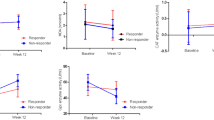Abstract
Rationale
Several investigators implicated role of free radical-mediated pathology in schizophrenia. No study has ever examined the effect of vitamin C with atypical antipsychotics in the treatment of schizophrenia.
Objective
The aim of this study was to examine the effect of oral vitamin C with atypical antipsychotics on serum malondialdehyde (MDA), plasma ascorbic acid levels, and brief psychiatric rating scale (BPRS) score in schizophrenic patients.
Method
Forty schizophrenic patients participated in a prospective, double-blind, placebo-controlled, noncrossover, 8-week study. The patients with schizophrenia were divided randomly into placebo and vitamin C group of 20 each. Serum MDA and plasma ascorbic acid were estimated by methods of Nischal and Aye, respectively.
Result
Increased serum MDA and decreased plasma ascorbic acid levels were found in schizophrenic patients. These levels were reversed significantly after treatment with vitamin C along with atypical antipsychotics compared to placebo with atypical antipsychotics. BPRS change scores at 8 weeks improved statistically significant with vitamin C as compared to placebo.
Conclusion
Oral supplementation of vitamin C with atypical antipsychotic reverses ascorbic acid levels, reduces oxidative stress, and improves BPRS score, hence both the drugs in combination can be used in the treatment of schizophrenia.
Similar content being viewed by others
References
Altuntas I, Aksoy H, Coskun I, Caykoylu A, Akcay F (2000) Erythrocyte superoxide dismutase and glutathion paraoxidase activities and malondealdehyde and reduced glutathione levels in schizophrenic patients. Clin Chem Lab Med 38:1277–1281
Arvindakshan M, Sitasawad S, Debsikdar V, Ghate M, Evans D, Horrobin DF, Bennett C, Ranjekar PK, Mahadik SP (2003a) Essential polyunsaturated fatty acid and lipid peroxide levels in never-medicated and medicated schizophrenia patients. Biol Psychiatry 53:56–64
Arvindakshan M, Ghate M, Ranjekar PK, Evans DR, Mahadik SP (2003b) Supplementation with a combination of omega 3 fatty acids and antioxidants (vitamin E and C) improves the outcome of schizophrenia. Schizophr Res 62:195–204
Aye K (1978) A simple colorimetric method for ascorbic acid determination in blood plasma. Clin Chim Acta 86:153–157
Blakely RD, Wages SA, Justice JB, Hernbon JB, Neill DB (1984) Neuroleptics increase striatal catecholamines metabolites but not ascorbic acid in dialyzed perfusate. Brain Res 308:1–6
Cadet JL, Brannock C (1997) Invited review-free radicals and pathobiology of brain dopamine system. Neurochem Int 32:117–131
Cadet JL, Lohr JB (1987) Free radicals and developmental biopathology of schizophrenic burnout. Integr Psychiatr 51:40–48
Dakhale G, Khanzode SD, Khanzode SS, Saoji A, Khobragade L, Turankar A (2004) Oxidative damage and schizophrenia: the potential benefit by atypical antipsychotics. Neuropsychobiology 49:205–209
Englard S, Seifter S (1986) The biochemical functions of ascorbic acid. Annu Rev Nutr 6:365–406
Fridovich I (1983) Superoxide radical: an endogenous toxicant. Annu Rev Pharmacol Toxicol 23:239–257
Hadjiconstanttinou M, Neff NH (1983) Ascorbic acid could be hazardous to your experiments: a commentary on dopamine receptor binding studies with speculation on a role for ascorbic acid in neuronal function. Neuropharmacology 22:939–946
Kei S (1978) Lipid peroxides in cerebrovascular disorders determined by new colorimetric method. Clin Chim Acta 90:37–43
Kuloghi M, Ustundag B, Atmaca M, Canatan H, Tezean AE, Cinkiline N (2002) Lipid peroxidation and antioxidant enzyme levels in patients with schizophrenia and bipolar disorder. Cell Biochem Funct 20:171–175
Liu J, Mori A (1993) Monoamine metabolism provides an antioxidant defense in the brain against oxidant and free radical induced damage. Arch Biochem Biophys 302:118–127
Mahadik SP, Mukherjee S, Correnti I, Sheffer R (1995) Elevated levels of lipid peroxidation products in plasma from drug-naive patients at onset of psychosis. Schizophr Res 15:66–70
Oke AI, May L, Adams RN (1987) Ascorbic acid distribution pattern in human brain. In: Bums JJ, Reverse JM, Machlin LJ (eds) Third conference on Vit C. Ann NY Acad Sci pp 1–12
Overall JE, Gorham DR (1962) The brief psychiatric rating scale. Psychol Rep 10:799–812
Padh H (1990) Cellular functions of ascorbic acid. Biochem Cell Biol 68:1166–1173
Reddy R, Mahadik SP, Mukherjee M, Murty JN (1991) Enzymes of the antioxidant system in chronic schizophrenic patients. Biol Psychiatry 30:409–412
Sen CK, Hanninen O (1994) Physiological antioxidants. In: Sen CK, Packer L, Hanninen O (eds) Exercise and oxygen toxicity. Elsevier Science Publishers, B.V., Amsterdam
Seregi A, Schaefer A, Komlos M (1978) Protective role of brain ascorbic acid content against lipid peroxidation. Experientia 34:1056–1057
Vaiva G, Thomas P, Leroux JM (1994) Erythrocyte superoxide dismutase determination in positive moments of psychosis. Therapie 49:343–348
Vera JC, Rivas CI, Fischbarg J (1993) Mammalian facilitative hexose transporters mediate the transport of dehydroascorbic acid. Nature 364:79–82
Washko PW, Wanw Y, Levine M (1993) Ascorbic acid recycling in human neutrophils. J Biol Chem 268:15531–15535
Author information
Authors and Affiliations
Corresponding author
Rights and permissions
About this article
Cite this article
Dakhale, G.N., Khanzode, S.D., Khanzode, S.S. et al. Supplementation of vitamin C with atypical antipsychotics reduces oxidative stress and improves the outcome of schizophrenia. Psychopharmacology 182, 494–498 (2005). https://doi.org/10.1007/s00213-005-0117-1
Received:
Accepted:
Published:
Issue Date:
DOI: https://doi.org/10.1007/s00213-005-0117-1




